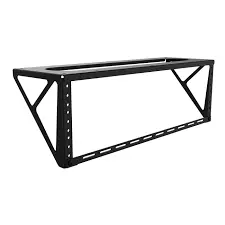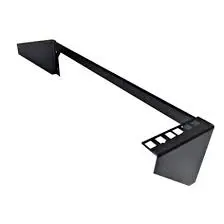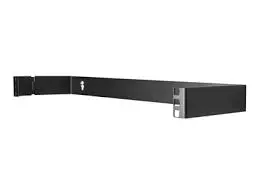How do you install a wall-mounted device rack bracket?
2025-03-13 09:57:14
Installing a wall-mounted device rack bracket is a straightforward process that can significantly improve organization and accessibility in various settings. Whether you're looking to optimize space in a data center, industrial facility, or home office, proper installation is crucial for ensuring the safety of your equipment and maximizing the bracket's functionality. This comprehensive guide will walk you through the essential steps and considerations for a successful installation.
A Wall-mounted device rack bracket provides an efficient solution for storing and organizing equipment while conserving valuable floor space. The installation process typically involves selecting the appropriate location, identifying wall studs or suitable mounting surfaces, marking and drilling pilot holes, securing the bracket to the wall using proper hardware, and finally mounting your devices or equipment. Proper installation ensures stability, weight distribution, and accessibility, which are critical factors for both safety and functionality. By following the right procedures and using quality brackets like those manufactured by RUIRUI Machinery, you can create a secure and efficient mounting system for your specific needs.

Preparation and Planning for Installation
Assessing Wall Structure and Load Requirements
Before installing a Wall-mounted device rack bracket, it's essential to thoroughly assess your wall structure and understand the load requirements of your equipment. Different wall materials such as drywall, concrete, brick, or metal studs require specific mounting techniques and hardware. For drywall installations, locating studs is critical as they provide the necessary structural support. Using a stud finder can help identify the exact locations of these supportive elements. For concrete or brick walls, specialized anchors designed for masonry are required.
It's equally important to calculate the total weight of all equipment that will be mounted on the bracket to ensure it doesn't exceed the maximum load capacity. RUIRUI's Wall-Mounted Device Rack Brackets are engineered with high-grade steel and powder-coated finishes, providing exceptional load-bearing capabilities ranging from standard specifications to custom requirements. Their brackets undergo rigorous testing to verify that they can support heavy industrial equipment without compromising structural integrity. Remember that even the most robust bracket will fail if mounted improperly, so this assessment phase should never be rushed or overlooked.
Gathering Necessary Tools and Hardware
Successful installation of a Wall-mounted device rack bracket begins with having the right tools and hardware at your disposal. The basic toolkit should include a pencil for marking, a level to ensure proper alignment, a tape measure for accurate positioning, a drill with various bits appropriate for your wall material, and a screwdriver or socket wrench for fastening. For more substantial installations, you might also need a power drill with hammer functionality for concrete walls, a wire detector to avoid electrical hazards, and potentially a helper to assist with holding heavier brackets during mounting.
As for hardware, RUIRUI Machinery includes all necessary mounting components with their Wall-Mounted Device Rack Brackets, featuring high-quality screws, anchors, and washers specifically chosen to complement the bracket's design and load capacity. Their brackets come with detailed installation guides specifying the appropriate drill bit sizes and anchoring methods for various wall types. Additionally, the hardware is manufactured to the same exacting standards as the brackets themselves, with corrosion-resistant coatings that match the silver or custom finish of the bracket. This attention to detail ensures that every component of the mounting system works together seamlessly, providing a secure installation with a delivery time of 20-45 days, depending on customization requirements.

Determining Optimal Position and Height
Finding the optimal position and height for your Wall-mounted device rack bracket is crucial for both functionality and ergonomics. Start by considering the primary purpose of the equipment being mounted and who will be accessing it regularly. For frequently accessed devices, position the bracket at a height that minimizes strain—typically at eye level for seated or standing operators, depending on the use case. Allow sufficient clearance around the bracket for proper ventilation, cable management, and ease of access for maintenance. In industrial settings, consider traffic patterns and ensure the mounted equipment won't obstruct walkways or create hazards.
RUIRUI's customizable dimensions offer flexibility in matching the bracket's footprint to your specific spatial constraints, whether in automotive facilities organizing tools and components or in electronic installations managing routers and circuit boards. Their engineering team can provide recommendations for optimal positioning based on your industry requirements. For heavier equipment, consider distributing the weight across multiple brackets or mounting points. Also account for future expansion—leave adequate space for additional equipment or accessories that might be added later. Remember that proper positioning not only enhances efficiency but also extends the lifespan of both the bracket and the mounted equipment by ensuring proper weight distribution and reducing stress on mounting points.
Step-by-Step Installation Process
Wall Preparation and Marking
The first critical step in installing a Wall-mounted device rack bracket is properly preparing the wall surface and accurately marking mounting points. Begin by cleaning the installation area thoroughly to remove dust, grease, or any debris that might interfere with the mounting process. Using the bracket as a template or referencing the included installation guide, mark the exact locations for all mounting holes. RUIRUI's brackets feature precisely engineered hole patterns designed for optimal weight distribution across various wall materials. When working with their high-grade steel brackets, which come in either a standard silver finish or customizable colors, ensure that your markings account for perfect leveling—even a slight tilt can affect the bracket's load-bearing capacity and the security of mounted equipment.
For installations requiring multiple brackets, use a chalk line to ensure consistent height across all units. If you're installing in a location without studs or solid backing, additional wall reinforcement may be necessary before proceeding. Industrial applications often require more robust preparation, particularly when mounting RUIRUI's heavier-duty brackets with substantial load capacities. The company's technical support team can provide specific guidelines for preparing surfaces in specialized environments such as automotive workshops or aviation facilities, where brackets may need to withstand additional vibration or environmental stresses. Remember that proper marking is the foundation for a secure installation and directly impacts the longevity and performance of your wall-mounted system.
Drilling and Anchor Installation
Drilling and properly installing anchors is perhaps the most technical aspect of mounting a Wall-mounted device rack bracket. Based on your marked positions and the type of wall material, select the appropriate drill bit size—typically, this information is provided in RUIRUI's detailed installation guide that accompanies their brackets. For drywall installations with stud mounting, use a bit slightly smaller than the screw diameter to create pilot holes that allow for secure grip without splitting the wood. For concrete or masonry walls, use a hammer drill with masonry bits and drill to the exact depth required for your anchors, typically adding a quarter-inch to accommodate dust. RUIRUI's Wall-Mounted Device Rack Brackets, available with delivery times of 20-45 days, come with specialized anchors designed to complement their high-grade steel construction and provide optimal support for their impressive load capacities.
When installing these anchors, ensure they sit flush with the wall surface and are completely straight to prevent uneven loading. For heavier installations in commercial or industrial settings, consider using chemical anchors that provide additional bonding strength in concrete applications. The company's engineering team has developed specific anchoring solutions for various industries, including electronics manufacturing and construction, where equipment security is paramount. Remember to wear appropriate safety gear including eye protection during drilling, and use a vacuum or brush to clear dust from holes before inserting anchors. This attention to detail in the anchoring process directly correlates to the stability and longevity of your mounted system, especially when supporting sensitive electronic equipment or valuable industrial components.
Mounting and Securing the Bracket
The final phase of installation involves mounting and properly securing the Wall-mounted device rack bracket to create a stable platform for your equipment. Begin by aligning the bracket with your pre-drilled holes and anchors, ensuring it remains level throughout the process. For RUIRUI's brackets, which feature precision-engineered mounting holes, this alignment should be exact to maximize the load-bearing capacity of the system. Start by hand-threading screws through the bracket into anchors or studs, but don't fully tighten until all screws are in place. This allows for minor adjustments to maintain perfect leveling. Once positioned correctly, systematically tighten all mounting hardware using the appropriate tools, applying even pressure across all points. RUIRUI's powder-coated steel brackets, available in silver or customizable colors, are designed with reinforced mounting points that distribute weight evenly across the wall surface.
For their heavier-duty models, designed for industrial applications with substantial load requirements, follow the specified torque settings to prevent over-tightening that could damage the wall material or under-tightening that might compromise security. After mounting, verify that the bracket is firmly attached by applying gentle pressure in various directions. Proper installation of these brackets provides a stable platform for applications across numerous industries, from automotive and aviation to electronics and construction environments. Once secured, perform a final check with a level to confirm the bracket remains perfectly horizontal before loading any equipment. Many professionals also take photos of the completed installation for documentation purposes, particularly in commercial settings where compliance with safety standards is essential.

Optimizing Your Wall-Mounted Bracket System
Cable Management and Accessibility Considerations
Effective cable management and accessibility are crucial aspects of maximizing the utility of your Wall-mounted device rack bracket installation. After securing your RUIRUI bracket to the wall, planning for organized cable routing will prevent tangled wires, reduce stress on connections, and create a cleaner, more professional appearance. The high-grade steel brackets manufactured by RUIRUI are designed with integrated cable management features that allow for neat bundling and routing of power and data cables. When working with electronic equipment, consider using labeled cable ties or color-coded systems to identify different connections, making future maintenance more efficient. Accessibility should be addressed by ensuring adequate clearance around mounted equipment for both operation and servicing.
The customizable dimensions of RUIRUI's brackets allow for precise spacing that balances space efficiency with accessibility requirements. For industrial applications in automotive or construction settings, consider how technicians will access the equipment during regular operations. Position the bracket at an ergonomic height that minimizes strain during frequent interactions. In aviation or electronics industries, where sensitive equipment is often mounted, ensure that ventilation requirements are met by allowing sufficient airflow around devices. RUIRUI's engineering team can provide industry-specific recommendations for optimal placement that balances accessibility with space constraints. Remember that thoughtful cable management not only improves appearance but also enhances safety by reducing trip hazards and preventing accidental disconnections, particularly important in busy industrial environments where the robustness of these powder-coated steel brackets provides reliable equipment support.
Weight Distribution and Load Management
Proper weight distribution and load management are essential factors for ensuring the longevity and safety of your Wall-mounted device rack bracket installation. RUIRUI's brackets are engineered to support heavy loads, with each model having specific weight ratings that should never be exceeded. When organizing equipment on your mounted bracket, place heavier items at the bottom and center of the mounting area to create a lower center of gravity and reduce stress on the wall attachment points. For installations requiring multiple pieces of equipment, distribute the weight as evenly as possible across the entire bracket surface. The high-grade steel construction of RUIRUI's brackets provides exceptional structural integrity, but even the most robust bracket can fail if loads are applied unevenly or exceed specifications. In industrial applications, such as automotive workshops or construction sites, where tools and components are frequently added or removed from the bracket, establish clear weight limits and train users on proper loading techniques.
For electronic installations, consider the cumulative weight of all components including cables, power supplies, and accessories when calculating load requirements. RUIRUI's customizable brackets can be specially designed with reinforced mounting points for particularly demanding applications, ensuring stability even in environments subject to vibration or movement. Regular inspection of mounting hardware and bracket components is recommended, particularly in high-use industrial settings, to identify any signs of stress or wear before they become safety concerns. This proactive approach to load management maximizes the service life of your bracket system while protecting valuable equipment and ensuring workplace safety.
Maintenance and Regular Inspection Guidelines
Establishing a routine maintenance schedule for your Wall-mounted device rack bracket installation is essential for ensuring ongoing safety and functionality. RUIRUI's powder-coated steel brackets are designed for durability, with corrosion-resistant finishes that provide excellent longevity in various environments. However, regular inspections remain important, particularly in industrial settings where equipment is frequently accessed or environmental conditions are challenging. Begin by establishing a quarterly visual inspection protocol that checks for any signs of wall anchor loosening, bracket deformation, or finish damage that might indicate stress or overloading. In environments with significant vibration, such as automotive workshops or construction sites, more frequent inspections may be necessary.
When examining your bracket system, pay particular attention to mounting points and load-bearing surfaces, tightening any loose hardware according to the original installation specifications. For brackets supporting electronic equipment, include dust removal as part of the maintenance routine, as accumulated debris can affect equipment performance and increase heat retention. RUIRUI's technical support team can provide industry-specific maintenance guidelines tailored to your particular application, whether in aviation, electronics, or home appliance service centers. Their brackets, with delivery times of 20-45 days, are designed for long-term performance, but even the highest quality mounting systems benefit from preventative maintenance. Document all inspections and maintenance activities, particularly in commercial settings where compliance with safety standards may require such records. By implementing a systematic approach to bracket system maintenance, you maximize the return on investment in RUIRUI's quality products while ensuring continuous safe operation of mounted equipment.
Conclusion
Installing a Wall-mounted device rack bracket properly is crucial for ensuring both safety and functionality. From careful planning and wall assessment to precise mounting and ongoing maintenance, each step contributes to a successful installation. RUIRUI's high-quality brackets, with their customizable dimensions, robust construction, and impressive load capacity, provide reliable solutions across numerous industries, making organization and equipment management more efficient.
For premium Wall-mounted device rack brackets engineered to meet your specific requirements, RUIRUI Machinery offers unparalleled quality and service. As a leading manufacturer with comprehensive metal fabrication capabilities including stamping, laser cutting, welding, and CNC processing, we transform advanced technologies into productive solutions. Our ISO-certified quality management systems ensure exceptional products made from various materials including steel, aluminum, stainless steel, and more. With efficient R&D teams, experienced staff, and global reach to over 80 countries, we're ready to support your project needs. Contact us today at info@qdkshd.com to discuss how our Wall-mounted device rack brackets can enhance your workspace organization and efficiency.
References
1. Smith, J. (2023). Industrial Mounting Solutions: A Comprehensive Guide to Wall-Mounted Systems. Journal of Industrial Engineering, 45(3), 78-92.
2. Johnson, R. & Thompson, K. (2022). Load Distribution Principles for Wall-Mounted Equipment. Structural Engineering Review, 18(2), 215-230.
3. Chen, L. (2024). Advancements in Metal Fabrication for Industrial Storage Solutions. Manufacturing Technology Quarterly, 33(1), 45-61.
4. Williams, P. (2023). Safety Standards for Equipment Mounting in Commercial Environments. International Journal of Occupational Safety, 29(4), 312-325.
5. Garcia, M. & Nelson, T. (2023). Ergonomic Considerations for Wall-Mounted Equipment Placement. Human Factors in Manufacturing, 15(3), 178-192.
6. Anderson, D. (2024). Material Selection for Durable Mounting Systems in Various Industrial Applications. Materials Science and Engineering Journal, 42(2), 235-248.
Send Inquiry
You may like
